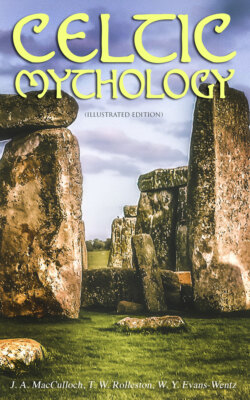Читать книгу CELTIC MYTHOLOGY (Illustrated Edition) - T. W. Rolleston - Страница 16
На сайте Литреса книга снята с продажи.
Strabo on the Celts
ОглавлениеThe geographer and traveller Strabo, who died 24 A.D., and was therefore a little later than Cæsar, has much to tell us about the Celts. He notices that their country (in this case Gaul) is thickly inhabited and well tilled—there is no waste of natural resources. The women are prolific, and notably good mothers. He describes the men as warlike, passionate, disputatious, easily provoked, but generous and unsuspicious, and easily vanquished by stratagem. They showed themselves eager for culture, and Greek letters and science had spread rapidly among them from Massilia; public education was established in their towns. They fought better on horseback than on foot, and in Strabo's time formed the flower of the Roman cavalry. They dwelt in great houses made of arched timbers with walls of wickerwork—no doubt plastered with clay and lime, as in Ireland—and thickly thatched. Towns of much importance were found in Gaul, and Cæsar notes the strength of their walls, built of stone and timber. Both Cæsar and Strabo agree that there was a very sharp division between the nobles and priestly or educated class on the one hand and the common people on the other, the latter being kept in strict subjection. The social division corresponds roughly, no doubt, to the distinction between the true Celts and the aboriginal populations subdued by them. While Cæsar tells us that the Druids taught the immortality of the soul, Strabo adds that they believed in the indestructibility, which implies in some sense the divinity, of the material universe.
The Celtic warrior loved display. Everything that gave brilliance and the sense of drama to life appealed to him. His weapons were richly ornamented, his horse-trappings were wrought in bronze and enamel, of design as exquisite as any relic of Mycenean or Cretan art, his raiment was embroidered with gold. The scene of the surrender of Vercingetorix, when his heroic struggle with Rome had come to an end on the fall of Alesia, is worth recording as a typically Celtic blend of chivalry and of what appeared to the sober-minded Romans childish ostentation.18 When he saw that the cause was lost he summoned a tribal council, and told the assembled chiefs, whom he had led through a glorious though unsuccessful war, that he was ready to sacrifice himself for his still faithful followers—they might send his head to Cæsar if they liked, or he would voluntarily surrender himself for the sake of getting easier terms for his countrymen. The latter alternative was chosen. Vercingetorix then armed himself with his most splendid weapons, decked his horse with its richest trappings, and, after riding thrice round the Roman camp, went before Cæsar and laid at his feet the sword which was the sole remaining defence of Gallic independence. Cæsar sent him to Rome, where he lay in prison for six years, and was finally put to death when Cæsar celebrated his triumph.
But the Celtic love of splendour and of art were mixed with much barbarism. Strabo tells us how the warriors rode home from victory with the heads of fallen foemen dangling from their horses' necks, just as in the Irish saga the Ulster hero, Cuchulain, is represented as driving back to Emania from a foray into Connacht with the heads of his enemies hanging from his chariot-rim. Their domestic arrangements were rude; they lay on the ground to sleep, sat on couches of straw, and their women worked in the fields.
